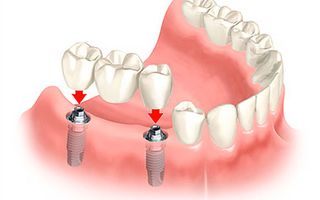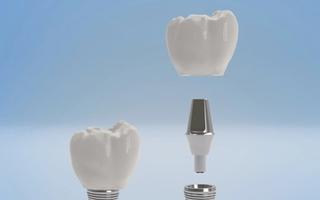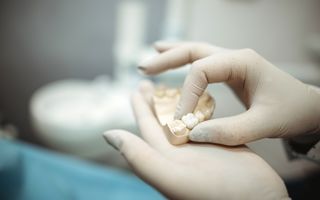
Dental Implants
Dental Implants are the 'Ultimate' in Dental Rehabilitation
Dental implants can replace a single missing tooth or several teeth.
The implant is made from biocompatible titanium. Dental implants are the most realistic and tooth-like method of replacing missing teeth.
An implant dentist can replace a single tooth, or many teeth. Millions of people world-wide have successfully had dental implants placed.
The literature supports a world-wide success rate in excess of 95% – an incredible success rate for any medical procedure.
What are dental implant?
A tooth implant is a small titanium fixture that functions as a replacement for the root portion of a missing natural tooth. Ultimately the implant can act as an anchor for a dental prosthesis.

The prosthesis may be:
- Crown – replacing one missing tooth
- Bridge – replacing several missing teeth
- Overdenture – implants used to retain dentures
Dental implants are made of the most biocompatible metal known to man – chemically pure titanium. Three months after placement of the dental implant, adequate bone will have grown on to the surface of the implant so it is strong enough to withstand the daily forces of normal function. (This process is known as osseointegration.)
Are dental implants for me?
Implants can be placed so that they function totally independent of the remaining teeth.
People will often lose a tooth due to a traumatic incident. If the dentist were to use conventional bridgework to replace a missing tooth, the surrounding sound teeth would need to be prepared and shaped. This shaping process can expose these surrounding teeth to nerve damage.
The beauty of the dental implant is that it can be placed without involving (much less damaging), the surrounding sound teeth.
The most ‘tooth-like’ replacement available.
The dental implant emerges from the gum, just like a real tooth (It doesn’t sit on top of the gum). An ‘implant-retained crown’ has a far superior appearance, compared to a dental bridge.
Placing a dental implant doesn’t damage the surrounding teeth Implants can be placed so that they function totally independent of the remaining teeth. People will often lose a tooth due to a traumatic incident. If the dentist were to use conventional bridgework to replace a missing tooth, the surrounding sound teeth would need to be prepared and shaped. This shaping process can expose these surrounding teeth to nerve damage. The beauty of the dental implant is that it can be placed without involving (much less damaging), the surrounding sound teeth.

What happens when you have a dental implant?
To place an implant, small incisions are made into your gum to expose the underlying jaw bone. Using special techniques and instruments, the implant is then inserted into the underlying jaw bone.
The surgical site is then closed around a healing abutment and the dental implant is allowed to heal 'osseointegrate' (bony integration) for a period of three months.
The placement of a dental implant is often divided into two stages -
- Stage 1 – Surgical phase
- Stage 2 – Restorative phase
Stages of a dental implant
There is always a surgical phase and a restorative phase. The time span between these stages may vary, depending on each individual case. In some cases, the implant can have a ‘tooth’ placed immediately. At other times, a healing period of about three months is necessary.

Surgical Phase
The implant surgery will be done in a comfortable and compassionate way at Geelong Smile Studio, under local anaesthetic using strict sterile operating techniques.
To place an implant, small incisions are made into your gum to expose the underlying jaw bone. Using special techniques and instruments, the implant is then inserted into the underlying jaw bone.
The surgical site is then closed around a healing abutment and the dental implant is allowed to heal ‘osseointegrate’ (bony integration) for a period of three months.
If the tooth test that you are missing and having replaced with a dental implant is in the aesthetic zone, you will be provided with an temporary denture. This will be placed immediately following the extraction of the tooth and insertion of the dental implant.
This temporary denture is to keep you looking good in the three months while waiting for the implant to complete osseointegration. That is, you will never be without your front tooth!

Restorative Phase
Three months following insertion of the dental implant, the degree of integration of the implant to the bone is tested with a simple ‘torque test’. This five minute procedure is completely painless and does not require any local anaesthetic.
Provided osseointegration has been successful, an additional 30 minute appointment will be scheduled to take an impression of the dental implant.
This impression is sent to a dental ceramist who will then construct the final crown. An appointment may need to be arranged between you and the ceramist so that the colour and contour of the final crown will be as natural as possible.
It usually takes three weeks for the dental ceramist to construct the crown.
At the final 30 minute appointment, the crown is tried in your mouth and provided that you are happy with the match to your existing teeth, the crown is then attached to the underlying implant. Again this procedure is often performed without local anaesthetic.
Maintaining optimal dental hygiene around your dental implant is a life-time commitment and will ensure the chances that your implant will remain successful.
Dental implants avoid bone loss that causes jaw shrinkage
The most ‘tooth-like’ replacement available.
The dental implant emerges from the gum, just like a real tooth (It doesn’t sit on top of the gum). An ‘implant-retained crown’ has a far superior appearance, compared to a dental bridge.
Placing a dental implant doesn’t damage the surrounding teeth Implants can be placed so that they function totally independent of the remaining teeth. People will often lose a tooth due to a traumatic incident. If the dentist were to use conventional bridgework to replace a missing tooth, the surrounding sound teeth would need to be prepared and shaped. This shaping process can expose these surrounding teeth to nerve damage. The beauty of the dental implant is that it can be placed without involving (much less damaging), the surrounding sound teeth.
Dental implants also stop the loss of bone from your jaw following extraction of teeth. When you have teeth extracted, bone is lost and shrinkage of the jaw bone occurs. This makes you appear older. A dental implant acts just like a real tooth Dental implants act and feel like your own teeth. Dental implants are fixed within your jaw bone and are not removable like a denture.

Frequently asked questions
The actual placement of the dental implant is not a lengthy procedure – definitely shorter than having a crown preparation or root canal procedure performed. The surgical time may take anywhere from 30 minutes to place one implant in a highly accessible location – up to an hour for more difficult cases. The complete implant procedure most commonly takes 4 months to complete but can take in excess of 12 months, especially if additional procedures such as bone grafting are required.
This is a difficult question as pain is obviously subjective. As with any surgical procedure, there will be some discomfort. However, it is true to say that most patients are extremely surprised with how little discomfort they have in the hours following the procedure and the following day. Most people report that they return to work pain free the following day. Some of our patients have even had the surgical stage completed in the morning and returned to a full working day. Most people are surprised at how ‘uneventful’ the entire implant procedure is. The consensus is that the placement of the implant is far less of an issue than the extraction of the natural tooth. As part of our standard practice, you will be adequately medicated with analgesics to ease any discomfort that may occur.
The current prerequisite for dental implants is that you have to have ceased growing. In girls this can be as young as 15-16 years of age with boys often 17-18 years of age. There is no particular upper age limit to the placement of dental implants. Good health is often the determining factor rather than age. Provided that there is adequate bone and healthy gums that are free of gum disease, then dental implants may be right for you. There are some chronic diseases that may complicate the placement of dental implants. A complete and thorough dental examination, as well as a medical examination and history, is imperative prior to the placement of dental implants.
There are some cases where either for systemic or local reasons, a dental implant may fail to integrate with the jaw bone. In this case the implant will be removed. The site will be cleaned out and allowed to heal for three months. Often another attempt can be undertaken in the following months to achieve osseointegration.
It is difficult to accurately quote the costs of dental implants without a customised treatment plan. Costs are dependent on several factors such as the number of implants that need to be placed, the number of teeth being replaced and whether grafting procedures are required or not. There are surgical variables and prosthetic variables to the total costs. To obtain a specific fee estimate, a thorough and customised diagnostic examination is necessary. This can be provided after the initial examination.
Talk to anyone who has had complete dentures or even a partial denture and they will tell you of the nightmares that they have had with their 'teeth'.
They will tell you how they have suffered for so long with the fear of their teeth flying out when they laugh or smile, the embarrassment of sneezing and losing their teeth.
With implants, stable dentures become a possibility.
An important application of dental implants is to help retain dentures. This type of denture is referred to as an implant retained overdenture.
Much like a press stud on a dentist’s clinical jacket, there is a male component attached to the implant with a female component housed within the denture. A minimum of two implants are required in the lower jaw, and often four to six implants in the upper jaw, to ensure the success of overdentures.
Overdentures – The appropriate standard of care for Complete Tooth Loss
At Geelong Smile Studio, we believe that the appropriate standard of care for complete tooth loss (edentulousness) in the lower jaw is the provision of implant retained overdentures. Implant Retained Dentures are biologically conservative. Implants that are placed to retain dentures can function with total independence of the remaining teeth. If conventional bridgework were to be used, the surrounding sound teeth often need to be prepared and shaped. The shaping process can expose these surrounding teeth to nerve damage. Dental implants can be placed without damage to the surrounding sound teeth.
Talk to anyone who has had complete dentures or even a partial denture and they will tell you of the nightmares that they have had with their ‘teeth’. They will tell you how they have suffered for so long with the fear of their teeth flying out when they laugh or smile, the embarrassment of sneezing and losing their teeth. People with complete dentures dream of maybe eating an apple or steak. They often suffer traumatic ulcers from constantly moving dentures, as well as pain from exposed nerves due to bone loss. There may be also a need for relines, as well as having to cope with sticky, messy denture adhesives, not to mention the inability to taste or grasp food properly. With implants, stable dentures become a possibility.
Results may vary in individual cases. The photo(s) used are stock photos of people who are not patients of Geelong Smile Studio, employees or affiliates.


